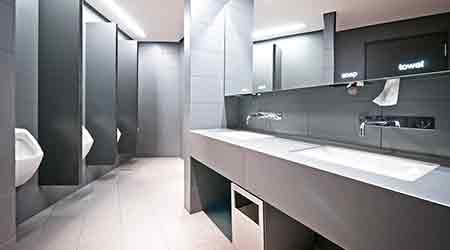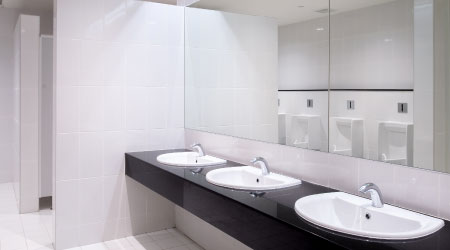Successful Strategies for Plumbing Upgrades
Part 1 of a 3 part article on retrofits aimed at curtailing water use
Maintenance and engineering managers — even those located outside of drought-stricken areas — understand that reducing water use benefits the bottom line and the environment.
Plumbing fixtures and equipment can account for nearly 50 percent of total water use in many institutional and commercial facilities. Depending on the type of facility and the number of occupants and visitors, a new generation of fixtures such as flush valves, faucets, and showerheads can provide significant water savings, particularly in older buildings with inefficient fixtures.
Plumbing and restroom upgrades are a popular tactic for reducing water use and cutting utility costs. Managers who avoid crucial mistakes during project planning and are up to speed on the latest in equipment are much more likely to deliver a successful project.
“Most managers understand that it’s crucial to keep up with the latest products and technologies to keep their facility running smoothly and efficiently,” says Darnell Wesson of Bradley Corp. “In our experience, they are generally willing to try new products if they are geared toward helping them save time and money.
“New-generation plumbing technology — for example, faucets that don’t require sensor windows, no-touch fixtures, or high-efficiency toilets — is designed to perform better and longer and be cost-efficient over time.”
Money matters
When managers begin planning for a plumbing upgrade, one common thought is to go make sweeping changes throughout the facility. That strategy is not always the wisest.
“What’s right for one facility’s retrofit scope might not be right for the next facility,” says Bob Carter of Zurn Industries. “There’s opportunities to save water if you target just your high-use restroom. You don’t have to do all 500 fixtures in a facility at once. You can start with where you get the biggest bang for your buck, like a front entrance or higher-use area. One (area) that’s way back in the corner that gets used once a week doesn’t necessarily need to be targeted.”
When selecting products for the retrofit, managers must consider the maintenance costs associated with new products, such as high-efficiency faucets or flush valves.
“Every manufacturer should be able to give you a standard list of routine maintenance parts, and you should be able to get from a manufacturer the projected cost of ownership with routine maintenance,” says Jason Fitzsimmons of Toto USA. “That should be part of the equation when you’re evaluating a retrofit. Not only are you going to conserve water and have a better sustainability message, but also think about what is the return of investment on that product, because it might turn out the ROI is completely upside down if the project has high maintenance costs.”
Shortcuts during specification can result in higher costs and more post-installation headaches.
“Settling for a lower-quality product will, in turn, impact the long-term cost of the project because the products won’t last as long as they should,” Wesson says.
Related Topics:















